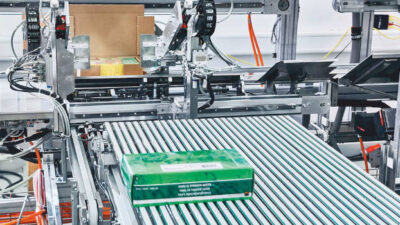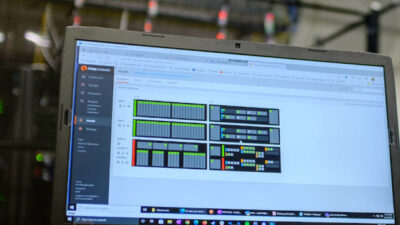Sensor network and calculation model confirm savings.
Evaporative cooling systems reduce the cost of operating the high-capacity compressors used for heating, ventilation and air conditioning (HVAC) in commercial and industrial buildings. By applying evaporative cooling to air drawn through condenser coils, HVAC-unit capacity increases while energy use decreases. Evaporative cooling reduces cost since a compressor needn’t run fully loaded as much as would otherwise be the case.
Evaporcool’s systems collect data to monitor a host compressor. The data is transmitted via internet to workstations running analytics software from Seeq. Evaporcool worked with Seeq to build an operational model that evaluates how cooling systems perform, applying heat-transfer and air-conditioning efficiency constants to the data.
The resulting "IIoT application" means managers monitor and measure the cooling system’s performance via internet.
If the model is furnished with historical data from a given installation, its results can be specific. Unfortunately, these histories are seldom sufficiently detailed to furnish a comprehensive baseline. However, using data compiled from similar installations, performance can be predicted. Either way, a picture emerges of what it costs to operate HVAC with and without the evaporative cooling system.
Understanding the operation
Think for a moment of the basic operation of an air-conditioning system: it circulates interior air over the system’s evaporator coil, absorbing building heat. The compressed, heat-laden refrigerant gas rises to a temperature higher than the outdoor ambient and moves to the outdoor condenser coil. Fans circulate outdoor air over the condenser coil, causing the refrigerant to condense and releasing heat to the outdoors. Cooled liquid refrigerant is returned to the evaporator to repeat the cycle.
As outdoor ambient temperature increases, the compressor works harder to establish the condenser temperature differential. On the other hand, the cooler it is outside, the more readily heat transfer and dissipation happens.
An evaporative cooling system has the same positive effect as running the HVAC system on a cooler day. The compressor doesn’t run as much to get the same cooling effect inside. Calculating the savings requires sensors to monitor condenser-air inlet temperatures, outside ambient conditions, compressor running time, current draw, and other parameters.
Turning this data into meaningful information requires the data-moving capabilities of IIoT to enable a system designer, armed with analytical tools, to create calculation algorithms and combine their results with historical data.
Seeq tools allow system designers and subject-matter experts to interact with the data. It might be necessary to adjust data, for example, when outside ambient temperature readings are distorted by sun shining directly on a temperature sensor at certain times of day.
What-if model evaluations
The model takes all relevant parameters and builds a picture based on actual experience. Sensor data fed into the operating calculations shows what is happening at that moment. The with-and-without cost-comparison capability is a major benefit, and a critical tool for users.
The energy consumption models developed by Evaporcool using Seeq tools have proven to be accurate, with an R-Value of .98. The closer the R-Value to 1, the better the model correlates to measured data.
Once the system is running, remote users can see the savings in real time via internet. A summary graph shows what is happening, compared to what would have happened without evaporative cooling. Reviewing the graph over time can identify pockets of savings, and the analytics application totals the value for any period.
The collected data provides additional value. Some is used for diagnostic purposes. For example, if the compressor motor current draw begins increasing with no corresponding operational change to account for it, the bearings may be deteriorating.
Once critical measurements are identified, upper and lower operating limits can be established, and appropriately alarmed. Managers can monitor operation remotely using IIoT connectivity. Those responsible for multiple sites can monitor performance from a central location.
The IIoT mechanics
For multi-site installations, each building has a master controller hosting a connection to the Evaporcool cloud infrastructure using a cellular-based virtual private network (VPN). This connection is shared among all the other units onsite, with "client" controllers attached to each HVAC unit via a local mesh network.
Each client transmits recorded data to the master controller, which consolidates the data and sends it to servers in the cloud. There it is stored, analyzed, and made available via the Evaporcool performance portal. This same infrastructure enables real-time data access for onsite testing and diagnostics, and to update configuration parameters.
Building managers use the portal to monitor equipment operational performance and energy costs. An optional BACnet connection integrates HVAC operational-performance information into any building management system. Dashboards deliver summary information for big-picture users, with drill-down available. Simple customizations deliver what information is needed. For example, energy managers want different variables than do maintenance teams.
Central monitoring points collect data generated by sensors, to verify outputs or identify trends in the granularity needed. Analytics tools make identifying trends and gradual changes affecting multiple systems or properties far easier. For example, extracting data during times of specific weather conditions or assessing the effects of changing thermostat-setting policies allows for accurate and objective evaluation.
Extending the model
With an accurate model, it becomes a simple matter to apply it in situations where historical data is not available. For example, if a property manager is using an evaporative cooling system at one location, by changing a few parameters, it is easy to see how the system will work in a different environment. Historical weather and temperature data for a given location can be added to the model and combined with measured performance data. It becomes possible to predict savings with a very high degree of accuracy.
Without the ability to capture data for analytics, users would have to resort to complex and time-consuming spreadsheet programming to perform data analyses. Combining internet connectivity with Seeq analytic software’s ability to create the mathematical functions and Evaporcool’s domain expertise creates an IIoT application delivering real benefits at reasonable cost.
Chris Curry is the president of Evaporcool. He has a bachelor of science degree from the U.S. Military Academy at West Point as well as an MBA from the University of Michigan’s Ross School of Business.
This article appears in the IIoT for Engineers supplement for Control Engineering and Plant Engineering.
See other articles from the supplement below.



